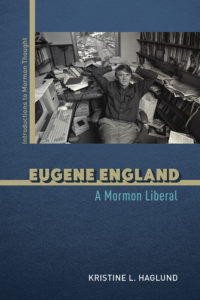Review
Title: Eugene England: A Mormon Liberal
Author: Kristine Haglund
Publisher: University of Illinois Press,
Genre: Biography
Year Published: 2021
Number of Pages: 152
Binding: Paperback
ISBN: 9780252086007
Price: $14.95
Reviewed by Kevin Folkman for the Association for Mormon Letters
This is my second review of a book about Eugene England in three months. While it may not be fair, it is difficult not to make comparisons between the two books. Terryl Givens’ Stretching the Heavens is a straightforward biography of the popular, and at times controversial, Mormon scholar and writer. Kristine Haglund’s Eugene England: A Mormon Liberal, the subject of this review, differs in being more of a treatment of England’s scholarship, his theological musings, and his impact on Mormon thought.
Despite Givens’ fine writing and deep research that produced a volume of more than 300 pages, I came away with a sense that Givens never really caught the full essence of Eugene England. And notwithstanding Given’s familiarity with England’s work and the obvious influence that he had on him (one of Givens’ books with his wife Fiona Givens is titled The God Who Weeps, an echo of England’s last published essay, The Weeping God of Mormonism), at less than half the pages, Haglund’s A Mormon Liberal captures a more accurate picture of who England was and why he was important.
The difference is in the treatment. Haglund’s volume is part of a series, Introductions to Mormon Thought, edited by Matthew Bowman and Joseph M. Spencer and published by the University of Illinois Press. Instead of a biography, Haglund chooses to focus on England’s contributions to theology and lived religion through his teaching, activism, and writing. In the process, Haglund finds the key to England’s lasting influence over several generations of students, scholars, and lay church members.
Haglund has organized England’s life and thought into four chapters. The first is a brief biography and examination of the influences that shaped him. She uses the symbol of “safe valleys” to describe the material influence of growing up in the deeply Mormon corridor of Utah and Idaho, and also a spiritual sense of having a safe haven in a family of faith, grounded in awareness of one’s place in the eternal scheme of things. Haglund then provides three chapters devoted to the ideas that manifested themselves in England’s life. Chapter Two pairs the idea of integrity with England’s writing, particularly personal essays, and his hopes for a faithful yet vibrant Mormon literature. England was both a critical reviewer of Mormon literature, as well as personally developing and advancing the personal essay as a particular Mormon genre. His collections of essays continue to inspire and inform Mormon letters with his powerful, yet always respectful voice.
Chapter Three discusses dialogue as a tool for exploring theology and reconciling differences. England never shied away from an opportunity to thoughtfully engage difficult and often painful topics in conversation with others of different viewpoints employed throughout his life. Haglund posits both the limitations and promise of dialogue and how England balanced what he once described as “speculative theology” with a commitment to faithfulness and a hope for reconciling competing ideas. As Haglund describes it, England sat at the “…fault line between Mormonism as a regional communitarian church, and Mormonism as a worldwide church with strong centralized authority over both doctrine and procedure.” [p57] Dialogue was to England as breathing is to the rest of us, a “…central organizing principle of his life and work.” [p46] He viewed it as a way to draw together and seek understanding in the absence of complete agreement.
Chapter four ventures into “…how Mormons can be divided (always imperfectly), and have divided themselves, into categories liberal and conservative…” both theologically and politically, and how England hoped to bridge those gaps via reconciliation, with the Atonement as a type. England was politically conservative, a lifelong Republican, yet embraced liberal ideas such as pacifism and a commitment to international humanitarian relief that he felt were grounded in basic Christian principles. Haglund shows how England viewed reconciliation through the example of the Atonement as foundational to promoting a healthy tension between opposing viewpoints. Compassion and faithfulness always underscored his thoughts and writings. Haglund also shows how easily misunderstood and difficult these efforts could be in actual practice. England often found his words and motives misunderstood by others less interested in the dynamics of dialogue and mutual respect.
There is a final bibliographical appendix that lists England’s major written contributions. This is organized by topics such as pacifism, gender, and Mormon literature. It’s a good overview for anyone interested in a deeper look into England’s thinking and impact on Mormon Studies. A final observation is important. While Givens viewed England as naïve, a term he used repeatedly in his biography of England, Haglund viewed that apparent naivety rather as the paradox of England being caught between his desire for constructive dialogue over differences, and the need to remain faithful to the church and its hierarchical leadership invested in historical authority. Overall, Haglund’s brief Eugene England: A Mormon Liberal effectively frames England’s place in the greater trends of Mormon thought and theology in the latter half of the 20th century, providing us a model for dialogue that continues to be needed in the 21st.

